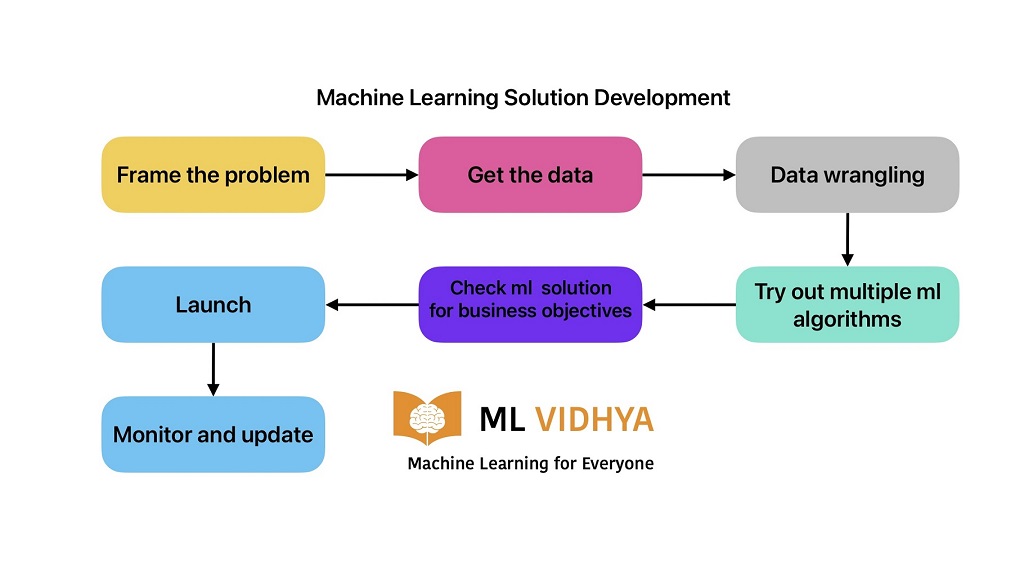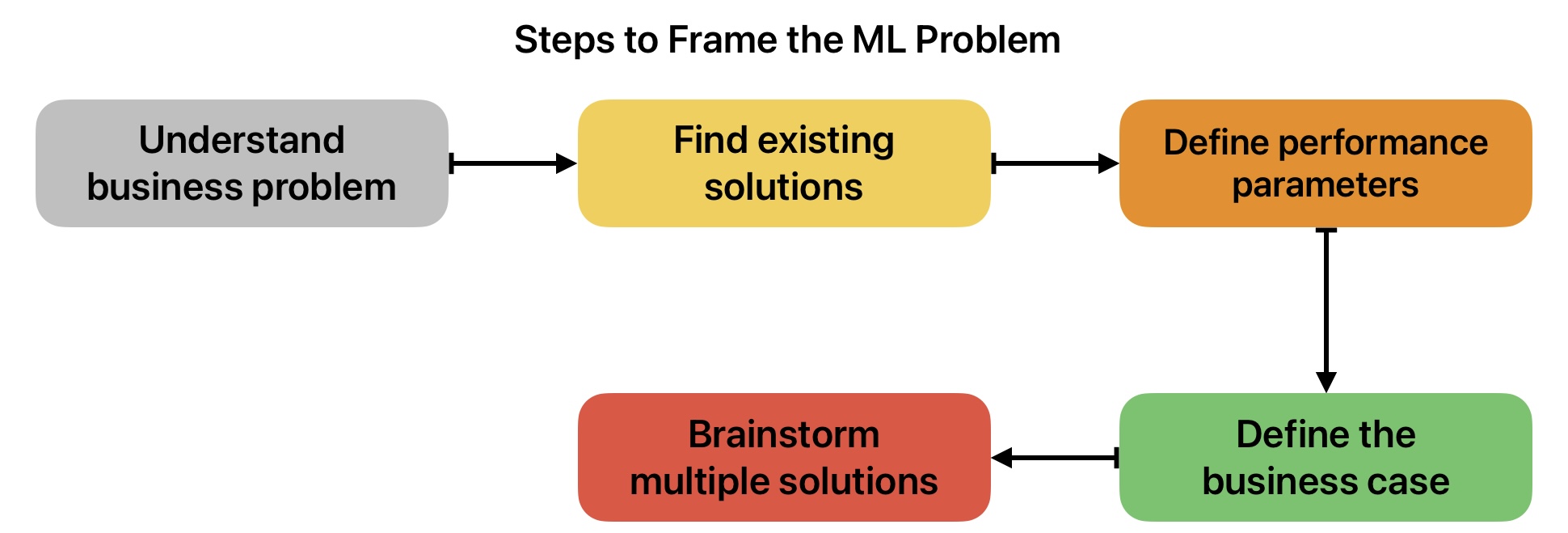Machine Learning is not about fitting the data and predicting values. There are multiple steps in machine learning lifecycle to develop an optimized, predictive ML algorithm.
Table of Contents
ToggleSteps in Machine Learning Lifecycle: ML Solution Development
Here is the list of steps in machine learning lifecycle to develop an optimized machine learning algorithm.
- Frame the problem
- Get the Data
- Data Preparation
- Try Multiple Machine learning algorithms and the select the best one
- Check is ML Solution is meeting the business Objective
- Launch the Product
- Monitor and Update

Step 1: Frame the Problem
The first step in the Machine learning lifecycle for ML model development is to understand the underlying problem and brainstorm possible solutions. It involves the following steps.
- Understand the Business Problem.
- Find Existing Solutions
- Define performance parameters for ML solution.
- Brainstorm on multiple solutions.
- Define the business case.

Now we will try to understand these steps in detail. We suggest you read this article on activities to convert business problems into ML Problem.
Understand the Business Problem
We need to understand the business perspective, and the solution end application to understand the business problem. We will understand this with an example.
Example to build understanding of a shop floor problem
You are working with a manufacturing firm, and the production manager tells you about low productivity due to unexpected machine breakdowns on the production line. These breakdowns are delaying customer orders, and customers are also not placing new orders.
Pause for a moment and try to understand the problem.
So, what is the problem’s root cause?
- Customer chunk
- Low productivity
- Delayed order
- Machine Breakdowns

All of the above are the business problems. But we can solve the first three problems just by solving the 4th one.
Find Existing Solutions
Now, when you understand the problem and the end objective. The next step is to look for the existing solutions.
Therefore, you decide to go to the shop floor and talk to the manufacturing team to understand the existing solutions to stop breakdowns.
Machine maintenance engineers tell you: they do machine maintenance after certain machine working hours. Each operator fills machine working hours in a sheet manually.

Now you are curious!!
Why does machine breakdown occur if we are doing machine maintenance within a defined time?
Maintenance officials give the following rational.
- The monitoring sheet may be less accurate
- Sometimes, machine maintenance is delayed due to customer orders.
Define Performance Parameters For ML solution
Define the performance parameters to analyze your solution. If any solution still exists, your solution must add value in terms of cost, quality, or value delivery.
The manufacturing team suggests that the existing solution is a good solution if implemented well.
They monitor the number of machine breakdowns in a month to define their performance.
Brainstorming on Solutions
The next step is to brainstorm on all possible solutions with some assumptions backed by data or experience. While brainstorming for a solution, don’t constrain yourself with machine learning. Explore other ML solutions as well.
You find out this is a common problem that manufacturers face. Afterward, you suggest following two solutions.

Example
We can use smart energy monitoring system to monitor machine and determine machine running time accurately. Further, you can raise an alarm or shut it down if machine maintenance is not done in a defined time. (This solution does not require the implementation of ML)
In phase 2, you plan to collect the machine usage and current data from the smart plug and implement the predictive maintenance.
Define Business Case
After discussion with your superiors and team, you make the following business case:
We can reduce the machine breakdown by 50%. It will save “X” million in the next three years, and solution implementation cost is “0.5 X. Apart from this direct benefit of “0.5 X”, we will improve our customer satisfaction and can get more orders.
If your team agrees, you can move ahead with the proposed solution.
Step 2: Get the data
The next step in machine learning lifecycle for ML model development is to get the required data. Developed ML model quality depends on input data. We can get the required data for ML model development in following steps:
- Make a decision on what data is required.
- Identify the data source and get the data
- Convert data into required format
- Data exploration

Make a decision on what data is Required
From the above understanding, you can easily conclude what data you need to get the solution working.
Pause for a moment and brainstorm on what data you need !!

As per my understanding, you will require the following data:
- All machine maintenance schedules.
- Machine maintenance, breakdown, and runtime history(This will be a time series data).
- Machine current consumption with time: We will use this data during phase-2 development.
Identify Data Source and Get the Data
Identify the data source and get the data for each machine maintenance schedule, machine maintenance, and breakdown with runtime history.
A more possibility is that the machine’s current consumption data is not available. In this case, you can identify a device or system to monitor the machine’s current consumption.
Now, you have access to a lot of company-sensitive data. It is your responsibility to use this data carefully. Your competition can use this data to get insights into your company’s operations.
Convert the data into the required format
We can get the automated data in the required format without any challenge. However, data from maintenance personnel can be in Excel sheets, handwritten documents, etc. Your job is to convert this data into usable format.

Shuffle and split the data for training, testing, and validation. Data shuffling may improve the model accuracy by reducing the variance. It ensures the ML algorithm is generalizing without over-fit problems.
Need for data conversion for Machine Learning
Let’s consider a case where you have population height, country, and gender data, and the data is arranged according to gender.
We can have the following possibilities if you split this data into training and test data in a 70-30 ratio without shuffle.
- The training data will have females.
- And test data will have most of the males.
Therefore, there is more possibility the model will not generalize for male height data. We don’t know the model performance with females if we do not have female data in the validation test.
Data Exploration
Nowadays, it is straightforward to collect and store data. But the challenge is to get insights and valuable Information from that data. Data exploration is one of the significant steps in Machine Learning model development.
Data exploration gives a deeper understanding of a dataset that aids you in data preparation for ML and selecting the best algorithm for your application. The better you know the data you are working with, the better the analysis will be. We can Python NumPy and Pandas library for data exploration tasks.

Let’s consider a case where you got a dataset from an OBD device. You will be curious to know the following points:
- How many rows and columns (Features) are there in the data?
- What are the names of the features?
- Determine data type: Float, Object, etc.
- Missing values.
- Identify the outliner.
- Determine patterns and relationships in data features: Correlation matrix.
- Univariate and bivariate analysis.
Step 3: Prepare the data
The next step in the machine learning lifecycle for ML model development is to transform the raw data into the required format and remove all anomalies from the data. Data preparation involves transforming raw data to analyze it and run inside the machine learning algorithm.
Python NumPy, Pandas, and matplotlib Library are the best libraries to prepare data for ML model development.

We do data preparation to solve one of the following errors:
- Remove missing data.
- Deal with anomalies.
- Convert categorical data into numerical values.
- Remove unwanted features.
- Combine multiple features into one feature.
- Get data in the required format: Time stamp example.
- Normalize/standardize the data.
Step 4: Try out multiple ML models and select the best one - Critical Step in Machine Learning Lifecycle
After we have the data ready, the next step in ML lifecycle is to input this training data into machine learning algorithms to develop the ML model. Afterward we validate the ML model on validation data on required performance parameters.

For example, we can use linear classifiers, Support vector machines, and decision trees for classification tasks.
But just by looking at data, you cannot tell which algorithm will perform best. Therefore, experts recommend checking all the available ML solutions and traditional approaches to finalize the solution.
Step 5: Check if your ML solution is meeting the business objective
When the solution for the defined problem is ready, the next step in machine learning lifecycle is to check whether your solution is meeting the initially set business objective.

You can make machine learning solution prototype to get feedback from all stakeholders. We can launch the solution if team agrees and the solution meets the business objective.
Step 6: Product Launch: Milestone in Machine Learning Lifecycle
You need to ensure your solution is production-ready before launch. Production-ready solution means all workflows, such as data input, data preparation, and prediction are automated with minimal human interference.
Step 7: Monitor and update
Is your work completed after the product launch?
The answer is No.
You need to create a system to monitor the ML model performance at regular intervals, and trigger alerts when model performance is not up to mark.
Degrade in ML model performance is a common problem because data evolves with time. And we can solve this by regularly training the model on fresh data. Sometimes, we need human expertise to monitor the ML model.
Therefore continuous monitoring and update in ML algorithm is one of the important step in Machine learning lifecycle.
